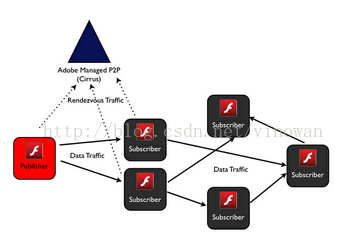萬盛學電腦網 >> 網絡應用技術 >> 應用教程 >> flashP2P協議rtmfp解析
flashP2P協議rtmfp解析
1 協議介紹
Real-Time Media Flow Protocol(簡稱RTMFP)是Flash和Flash之間基於UDP的點對點傳輸協議,由Adobe公司在2008年在Flash 10.0中發布,隨後在Flash10.1中加入了Groups功能。
2 常見用法
rtmfp在Flash 10中的典型使用場景如下圖:

它有如下特點:
l 使用Cirrus或者開源的Cumulus來提供Rendezvous服務
l Cirrus或者Cumulus並不提供Peer ID的交換服務,需要提供其它的方式來交換客戶端之間的Peer ID
l Flash客戶端之間使用NetStream來做點對點傳輸,Publisher需要給每一個Subscriber單獨傳輸一份數據,這也限制集群的規模。
為了解決這個問題,Adobe在Flash 10.1中提出了Groups的概念,典型的架構如下:

它有如下特點:
l Cirrus或者開源的Cumulus提供Rendezvous服務並提供所有連接client列表
l client從Cirrus或者開源的Cumulus獲取鄰居節點之後,就可以組成一個完整的P2P架構,所有的audio、video和data數據都在peer之間交互。
3 協議解析
3.1 基本概念
l session:session是兩個UDP地址之間的雙向管道。
l flow:flow是從一個實體到另一個實體之間的邏輯路徑。一個session可以包括多個flow。
l packet:網絡中實際傳輸的數據,一個packet可以包含多個message。數據傳輸時都經過了128 bit的AES加密
l message:audio、video和data數據。
3.2 Scrambled Session ID
rtmfp協議中每個包的格式如下:
packet := scrambled-session-id | encrypted-part
其中scrambled-session-id是4字節,其後是經過AES加密的數據體。
scramble-session-id的生成規則如下:
scrambled-session-id = a ^ b ^ c
這裡^代表XOR操作,a是session-id,b和c是encrypted-part的頭8個bytes。
當目標收到這個包後,unscramble的操作如下:
session-id = x ^ b ^ c
其中x是scrambled-session-id,b和c同上。
使用scramble-session-id的目的為了減少數據包流經的NAT設備和layer-4 packet inspector對數據的干擾。
session-id用於標識通信雙方建立的連接,並確定通信時使用的加密和解密的key,這些key是通過DH key exchange算法獲得。但在session建立之前,雙方使用一個公有加密key,即128 bit的字符串”Adobe System 02”。
3.3 raw part
encrypted-part經過解密之後就得到了raw-part,它的格式如下:
raw-part := checksum | network-layer-data | padding
其中checksum有16字節,network-layer-data是變長數據,padding都是0xFF,並把network-layer-data補齊為16字節的倍數,這是因為rtmfp使用的是16字節的加解密key。
checksum基於network-layer-data和padding計算。
3.4 network layer data
network-layer-data的格式如下:
network-layer-data = flags | timestamp | timestamp-echo | chunks
其中flags為1個字節,其格式如下:
7 6 5 4 3 2 1 0
TC TCR reserved reserved TS TSE mode
l mode:11代表握手包,01代表initiator發送包,10代表responder發送包,00不是合法值
l TSE:包中是否包含timestamp-echo域
l TS:包中是否包含timestamp域
l TCR:time critical reverse notification表明發送方正在從其它地方收到timecritical包
l TC:time critical forward notification表明發送方發送的是timecritical包
timestamp域有2字節,精度是4ms,他的計算方式如下:
timestamp = int(time * 1000 / 4) & 0xFFFF
timestamp-echo域是server收到包的時間戳,當發送放收到這個值之後,發送方就可以計算RTT值了。
chunk類型的格式如下:
chunk = type | size | payload
type字段為1個字節,其中0xFF不可用,這個是用來區分chunk數據和padding數據的標記。type的定義如下:
typemeaning
0x30initiator hello
0x70responder hello
0x38initiator initial keying
0x78responder initial keying
0x0fforwarded initiator hello
0x71forwarded hello response
0x10normal user data
0x11next user data
0x0csession failed on client side
0x4csession died
0x01reset keepalive request
0x41reset keepalive response
0x5enegative ack
0x51some ack
size是2字節payload長度。
payload根據type的不同有不同的數據體。
3.5 message flow
session中包括3類消息:
l handshake:握手包,包括initiator hello, responder hello, initiator initial keying,responder initial keying, responder hello cookie change和responderredirect
l control:控制包,包括ping, ping reply, rekeying initiate, rekeying response, close, closeacknowledge, forwarded initiator hello.
l flow:流消息,包括user data, next user data, buffer probe, user data ack, user dataack, flow exception report.
session的建立是通過握手(handshake)來完成的,正常的messageflow如下:
如果是在NAT打洞是,cumulus server就作為一個forwarder,他會把initiatro hello包轉發到其它的client:
另外,cumulus server還可以讓client重定向到其它server:
這裡所說的client是Flash Player,而server是cumulus server或者Flash media server。當然server也可以給client發送initiator hello請求,這個在cumulus中被稱為man in the middle,不過這個特性還不穩定。
session的建立包括4次握手:
1 initiator -> target:initiator hello
2 target -> initiator: responder hello
3 initiator -> target:initiator initial keying
4 target -> initiator: responder initial keying
這個4次握手過程可以阻止Dos攻擊和syn-flooding攻擊。
每個session都有一個session-id來唯一標識這個session,並且session中的每個packet都會包含這個session-id,但是在session建立的4個握手包中,initiator-hello, responder hello和initiator initialkeying的session-id字段都是0,在發送最後一個包responder initial keying時,session建立成功並且session-id確定,所以responderinitial keying包含合法的session-id。
我們接下來詳細介紹一下這4個握手包
3.5.1 initiator hello
initiator hello包的格式如上所述,這裡只說明payload部分的格式:
initiator-hello payload = first | epd type | epd value| tag
其中:
l first:1 byte magic number
l epd type:1 byte,只有兩個合法值:
n 0x0a:client-server模式,epd value是想要連接的server的rtmfp url
n 0x0f:peer-to-peer模式,epd value是想要連接的client的peer id,一般是固定的32字節
l epd value:varlen + body
l tag:16 bytes隨機數
3.5.2 responder hello
responder hello包的payload格式如下:
responder hello payload = tag-echo | cookie | responder-certificate
其中:
l tag-echo:和initiator hello中的tag一致,但和initiator hello中不同的是,這裡在前面有一個varlen來表明tag的長度
l cookie:responder產出的64 bytes隨機數,用來防止syn-flooding攻擊
l responder certificate:diffie-hellman key exchange算法交換的信息,它的格式如下:
certificate= x01x0Ax41x0E | dh-public-num | x02x15x02x02x15x05x02x15x0E
dh-public-num是一個64 byte(128 byte)隨機數。
dh-public-num的生成規則為
y2 = g ^ x2 % p
其中g和p是公開的兩個數,其中g等於2,p是一個1024 bits的數,x2是responder隨機生成的數,y2就是在網絡中傳輸的dh-public-num。
3.5.3 initiator initial keying
initiator initial keying包的payload格式如下:
payload = initiator-session-id | cookie-echo | initiator-certificate| initiator-component | ‘X’
其中:
l initiator-session-id:initiator選擇的session-id,responder用它來發送數據給initiator(生成scrambled session id)
l cookie-ec
- 上一頁:路由器和交換器有啥區別
- 下一頁:去香港旅游如何上網?



